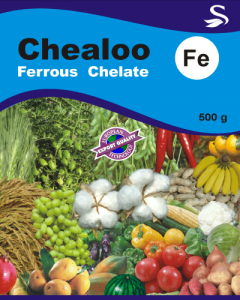
| Fe | 6.0 +/- 0.5 |
| pH Value (1% Solution) | 7.0 – 9.0 |
| Ortho – Ortho Content | 3.0 +/- 0.2% |
500 Gram
1 kg
10 kg
25 kg
Chelated Ferrous
Chelated Ferrous (Micronutrient)
Introduction :
Chelated Iron is an essential microelement for the growth of plants. Chelated ferrous plays an important role activating many enzymatic biochemical processes. It influences the content of chlorophyll and it is associated with the synthesis of proteins. It positively influences absorption of phosphorous, manganese, molybdenum and copper. Iron absorption by plants is, unfortunately, disturbed in all soils that show high pH and active limestone.
The addition of inorganic iron to the soil, in order to resolve the ferric chlorosis, shows no significant effect in most cases. The high quality Chelated Iron-EDDHA is in prevention and cure of this micro-deficiency, the most efficient among the treatments on the soil.Chelated EDDHA-Fe6 can be used by soil treatment and foliar spraying.
Chelated Iron is an essential micronutrient for plant (and algae) growth. Despite being one of the most abundant elements on the planet it is often the first element to become growth limiting for algae due to its physical chemical properties. Ferric oxide (Fe2O3) is the
most prevalent form of iron and has extremely low solubility and is often present in a hydrated or phosphate form (Fe2O3·H2O /
FePO4 ). At higher pH the hydroxide (Fe(OH)X) forms prevail (Hochmuth 2011). Iron hydroxide is even less soluble than the
hydrate or phosphate forms resulting in a tendency for iron deficiency under such conditions. At lower pH’s the solubility of iron
increases making iron exchange possible via humic and fulvic acids (natural chelators) in the soil and hence iron deficiency at
lower pH is generally less of a problem.
Chelated Iron is required in the algae cell for chlorophyll production although not being a part of the pigment itself. It is also present in
enzyme cofactors for nitrogenase, hydrogenase enzymes. Iron is an integral part of the electron transport systems cytochromes
found in chloroplasts and mitochondria as well as the iron containing protein ferredoxin that assist the electron transport reactions.
(Purves et al 1996;Lewandoska et al 2004; Kelley J.C.O1974).
Applying Iron Chelates:
Regardless of whether you use the DTPA or EDDHA, add 5 ounces of either product to each gallon of fertilizer concentrate and inject at a ratio of 1:100. This will apply 37.5 ppm iron and 45 ppm iron, respectively. Use the following tips for iron chelates:
- Apply when the media is dry to maximize absorption of the product.
- Apply in the morning and then rinse the foliage to prevent staining or burning the foliage.
- Do not apply to geraniums, New Guinea impatiens, marigolds, pentas, lisianthus or other high-iron sensitive crops.
- One Fe-EDDHA application is effective for one month, depending on growing medium pH and leaching.
- One Fe-DTPA application does not last as long as Fe-EDDHA, so it may need to be applied more frequently. Fe-DTPA application rates may need to be higher to obtain the same results.
- Store the product and mixed solutions in the dark as sunlight will degrade the chelate.
- If pH of the growing medium is high, apply potentially acidic fertilizers or use acid injection.
